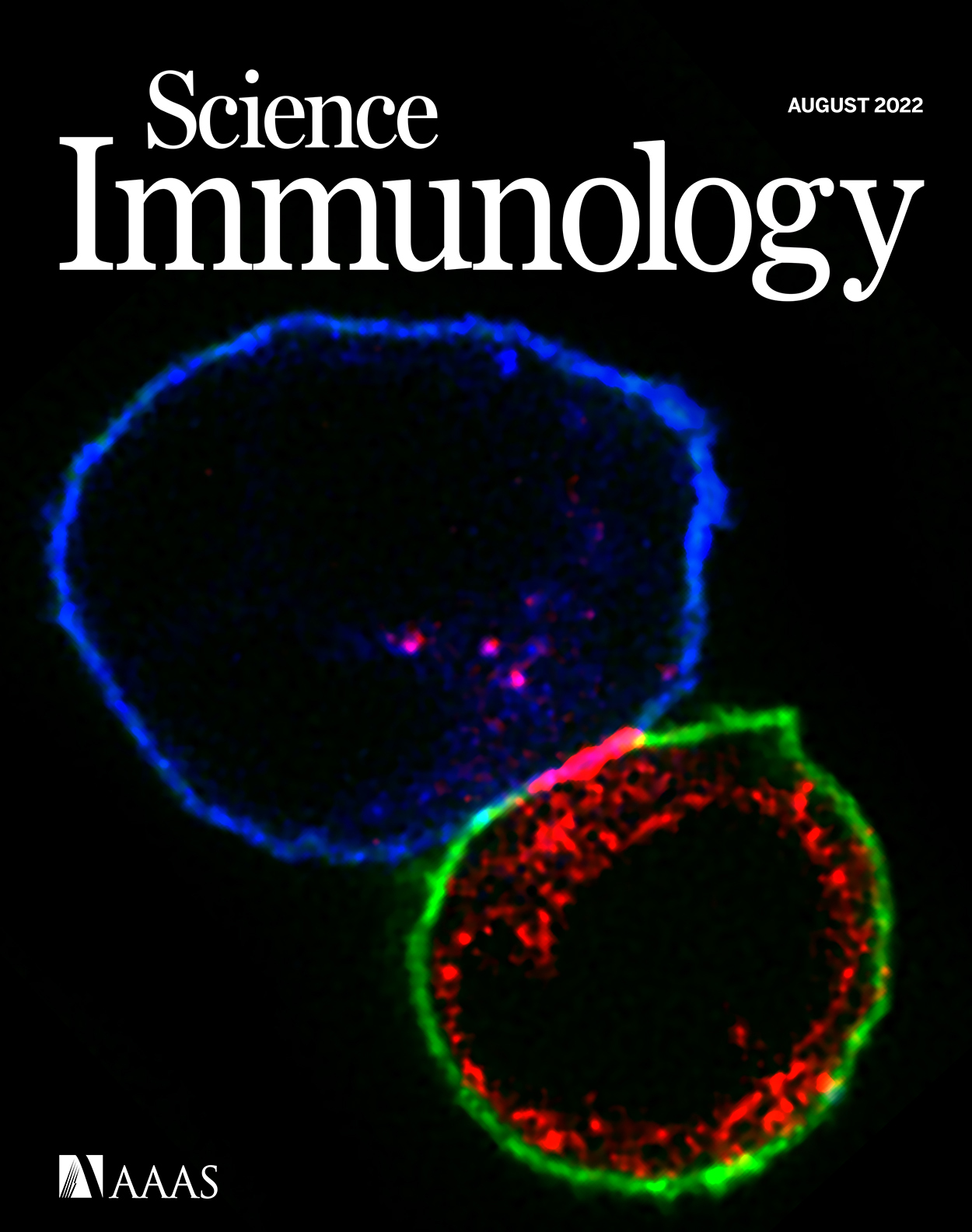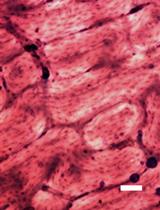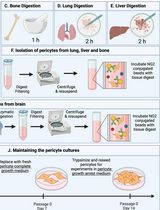- EN - English
- CN - 中文
Primary Mouse Invariant Natural Killer T (iNKT) Cell Purification and Transduction
原代小鼠恒定自然杀伤T(iNKT)细胞的纯化和转导
发布: 2023年07月05日第13卷第13期 DOI: 10.21769/BioProtoc.4707 浏览次数: 1976
评审: Luis Alberto Sánchez VargasXiaokang WuAnonymous reviewer(s)
Abstract
Invariant natural killer T (iNKT) cells are a non-conventional T-cell population expressing a conserved semi-invariant T-cell receptor (TCR) that reacts to lipid antigens, such as α-galactosyl ceramide (α-GalCer), presented by the monomorphic molecule CD1d. iNKT cells play a central role in tumor immunosurveillance and represent a powerful tool for anti-cancer treatment, notably because they can be efficiently redirected against hematological or solid malignancies by engineering with tumor-specific chimeric antigen receptors (CARs) or TCRs. However, iNKT cells are rare and require specific ex vivo pre-selection and substantial in vitro expansion to be exploited for adoptive cell therapy (ACT). This protocol describes a robust method to obtain a large number of mouse iNKT cells that can be effectually engineered by retroviral (RV) transduction. A major advantage of this protocol is that it requires neither particular instrumentation nor a high number of mice. iNKT cells are enriched from the spleens of iVα14-Jα18 transgenic mice; the rapid purification protocol yields a highly enriched iNKT cell population that is activated by anti-CD3/CD28 beads, which is more reproducible and less time consuming than using bone marrow–derived dendritic cells loaded with α-GalCer, without risks of expanding contaminant T cells. Forty-eight hours after activation, iNKT cells are transduced with the selected RV by spin inoculation. This protocol allows to obtain, in 15 days, millions of ready-to-use, highly pure, and stably transduced iNKT cells that might be exploited for in vitro assays and ACT experiments in preclinical studies.
Keywords: Primary iNKT cells (原代iNKT细胞)Background
Invariant natural killer T (iNKT) cells are a non-conventional T-cell population expressing a conserved semi-invariant αβ T-cell receptor (TCR), which is formed in mice by an invariant Vα14-Jα18 chain paired with a limited set of diverse Vβ chains (Bendelac et al., 2007). iNKT cells react to CD1d-restricted self and non self-lipid antigens in stress conditions, and are strongly implicated in tumor immunosurveillance (Godfrey et al., 2018). iNKT cells are evolutionary conserved; their investigation benefits from the availability of mouse models and the unequivocal detection, in mice and humans, by antigen-loaded CD1d tetramers and monoclonal antibodies specific for the semi-invariant TCR.
Several studies have shown that iNKT cells are an active component of the tumor microenvironment (TME) and control tumor progression by restraining cancer-supporting myeloid populations, such as modulating myeloid-derived suppressor cells and killing tumor-associated macrophages (De Santo et al., 2008 and 2010; Song et al., 2009; Liu et al., 2012; Gorini et al., 2017; Janakiram et al., 2017; Cortesi et al., 2018). Retargeting iNKT cells against cancer cells, by transducing tumor-specific TCR genes, generates enhanced effectors able to concurrently kill malignant cells and modulate detrimental myeloid cells in TME (Delfanti et al., 2022). This enhanced anti-tumor activity is peculiar of TCR-engineered iNKT, in which both the endogenous invariant TCR and the exogenous tumor-specific TCR exert anti-tumor effects—unlike conventional T cells, in which the endogenous TCRs are irrelevant for the therapeutic action, or even detrimental for possible off-target effects (Wolf et al., 2018). Therefore, iNKT cells are an attractive adoptive cell therapy (ACT) platform for engineering with anti-tumor TCRs or CAR (Heczey et al, 2020; Rotolo et al, 2018; Landoni et al, 2020; Delfanti et al., 2022), providing an appealing alternative to conventional T cells for the treatment of solid and hematological malignancies.
Because they are rare, iNKT cell harnessing for ACT requires two obligatory steps, consisting of ex vivo pre-selection followed by substantial in vitro expansion. We previously set up an optimized protocol for splenic iNKT cell purification and expansion (Delfanti et al., 2021) that can be used as the starting point for iNKT cell engineering. iNKT cells are enriched from the spleen of iVα14-Jα18 transgenic mice (iVα14 tg) (Griewank et al., 2007), in which iNKT cells are 30 times more frequent than in wildtype mice, significantly reducing the number of mice needed for the procedure. The setup of the cell culture requires only one day, instead of one week required by another widespread published protocol in which iNKT cells are stimulated with bone marrow–derived dendritic cells pulsed with the strong iNKT cell agonist α-GalCer (Chiba et al., 2009). In our protocol, iNKT cells are activated by anti-CD3/CD28 beads, and this activation is also useful for the retroviral (RV) transduction, which is done 48 h after. This procedure allows the generation of millions of ready-to-use, highly pure, and stably transduced iNKT cells within 15 days, so that they can be easily employed for functional studies (Figure 1). Indeed, by this method, we could engineer iNKT cells to express a second anti-tumor TCR (OT-I TCR), while maintaining the expression of the endogenous one, and we proved their efficacy both in vitro and in vivo (Delfanti et al., 2022). This protocol is also suitable for iNKT cell engineering with other effector molecules such as CARs or cytokines. A reporter gene, such as GFP, can also be introduced in the RV sequence to track iNKT cell transduction by flow cytometry over time.

Figure 1. Timeline for engineered invariant natural killer T (iNKT) cell production. Schematic representation of the protocol passages that lead to the generation of engineered iNKT cells.
Materials and reagents
Millex-HV 0.45 μm filter (Merck Millipore, catalog number: SLHVM33RS)
Polypropylene centrifuge tubes (Beckman Coulter, catalog number: 326823)
Microplate 96-well shape (Greiner Bio One, catalog number: 650101)
75 cm2 flask (Corning, catalog number: 430720U)
100 mm × 20 mm tissue culture dish (Falcon, catalog number: 353003)
5 mL polystyrene round-bottom tube (Falcon, catalog number: 352052)
70 μm cell strainer (Falcon, catalog number: 352350)
15 mL polypropylene conical tube (Euroclone, catalog number: ET5015B)
50 mL polypropylene conical tube (Euroclone, catalog number: ET5050B)
iVα14-Jα18 tg mice, strain name: C57BL/6-Tg(Cd4-TcraDN32D3)1Aben/J, purchased from the Jackson Laboratory (USA)
IMDM, with HEPES and L-Gln (Lonza, catalog number: 12-277F)
Hyclone FetalClone I (Cytiva, catalog number: SH30080.03)
Penicillin/streptomycin solution (Gibco, catalog number: 15140-122)
Phoenix-eco packaging cell line (ECO) cells, purchased from ATCC
Chloroquine (Sigma-Aldrich, catalog number: C6628)
dH2O, tissue-culture grade (Sigma-Aldrich, catalog number: W-4502)
TE buffer (Invitrogen, catalog number: 8019005)
Vector DNA plasmid, purified using PureLink, HiPure Plasmid Filter Maxiprep kit (Invitrogen, catalog number: K210017)
Dulbecco’s phosphate buffered saline (PBS) (Euroclone, catalog number: ECB4004L)
Fetal bovine serum (FBS), ultra-low endotoxin (Euroclone, catalog number: ECS0186L)
Purified rat anti-mouse CD16/CD32 (mouse BD Fc block), clone: 2.4G2 (BD Pharmingen, catalog number: 553142)
CD19-FITC, clone: 6D5 (BioLegend, catalog number: 115506)
H2(IAb)-FITC, clone: AF6-120.1 (BioLegend, catalog number: 114406)
TCRβ-APC, clone: H57-597 (BioLegend, catalog number: 109212)
Vβ5.2 PE/Cy7, clone MR9-4 (BioLegend, catalog number: 139508)
Mouse PBS57-CD1d-tetramer, provided by NHI tetramer core facility
DAPI (Santa Cruz, catalog number: SC-3598)
Live/Dead Zombie Violet Fixable Viability kit (BioLegend, catalog number: 423114)
Bovine serum albumin (BSA) fraction V (Roche, catalog number: 10735094001)
EDTA stock solution (Cayman Chemical Company, catalog number: 600215)
Anti-FITC microbeads (Miltenyi Biotec, catalog number: 130-048-801)
Anti-PE microbeads (Miltenyi Biotec, catalog number: 130-048-701)
LD column (Miltenyi Biotec, catalog number: 130-042-901)
Pre-separation filter (Miltenyi Biotec, catalog number: 130-041-407)
LS column (Miltenyi Biotec, catalog number: 130-042-401)
MS column (Miltenyi Biotec, catalog number: 130-042-201)
Dynabeads mouse T-Activator CD3/CD28 (Gibco, catalog number: 11452D)
RPMI 1640-GlutaMAX (Gibco, catalog number: 61870-010)
Non-essential amino acids (Gibco, catalog number: 11140-035)
Sodium pyruvate (Gibco, catalog number: 11360-039)
β-mercaptoethanol (Gibco, catalog number: 31350010)
Polybrene hexadimethrine bromide (Sigma-Aldrich, catalog number: H9268)
(hr)IL-2 (Chiron Corp)
Recombinant mouse IL-7 (R&D System, catalog number: 407-ML-025)
Paraformaldehyde (PFA) (Sigma-Aldrich, catalog number: P6148)
CaCl2 (Sigma-Aldrich, catalog number: C9702)
NH4Cl (Sigma-Aldrich, catalog number: A0171)
KHCO3 (Sigma-Aldrich, catalog number: 237205)
N2EDTA (BDH, catalog number: 280254-D)
NaCl (Sigma-Aldrich, catalog number: S5886)
HEPES (Sigma-Aldrich, catalog number: H4034)
Na2HPO4 (Sigma-Aldrich, catalog number: S3264)
IMDM + 10% Hyclone (see Recipes)
TE 0.1-H2O (see Recipes)
2× HEPES buffered saline (HBS) (see Recipes)
ACK (ammonium-chloride-potassium) lysing buffer (see Recipes)
MACS separation buffer (see Recipes)
Complete RPMI (see Recipes)
Equipment
MACS® MultiStand (Miltenyi Biotec, catalog number: 130-042-303)
QuadroMACSTM Separator (Miltenyi Biotec, catalog number: 130-090-976)
DynaMagTM-15 Magnet (Invitrogen, catalog number: 12301D)
Polyallomer centrifuge tubes (Beckman Coulter, catalog number: 326823)
Eppendorf centrifuge (Eppendorf, model: 5810 R)
Ultracentrifuge (Beckman Coulter, model: Optima XPN-90)
Rotor (Beckman Coulter, model: SW32Ti)
S@FEGROW 188 incubator (Euroclone)
FACS Canto II (BD Biosciences)
Software
FlowJo_V10 (BD Biosciences)
Procedure
文章信息
版权信息
© 2023 The Author(s); This is an open access article under the CC BY-NC license (https://creativecommons.org/licenses/by-nc/4.0/).
如何引用
Readers should cite both the Bio-protocol article and the original research article where this protocol was used:
- Delfanti, G., Dellabona, P. and Casorati, G. (2023). Primary Mouse Invariant Natural Killer T (iNKT) Cell Purification and Transduction. Bio-protocol 13(13): e4707. DOI: 10.21769/BioProtoc.4707.
- Delfanti, G., Cortesi, F., Perini, A., Antonini, G., Azzimonti, L., de Lalla, C., Garavaglia, C., Squadrito, M. L., Fedeli, M., Consonni, M., et al. (2022). TCR-engineered iNKT cells induce robust antitumor response by dual targeting cancer and suppressive myeloid cells. Sci Immunol 7(74): eabn6563.
分类
免疫学 > 免疫细胞分离 > 白细胞
细胞生物学 > 细胞分离和培养 > 细胞分离 > 免疫磁珠
细胞生物学 > 细胞工程
您对这篇实验方法有问题吗?
在此处发布您的问题,我们将邀请本文作者来回答。同时,我们会将您的问题发布到Bio-protocol Exchange,以便寻求社区成员的帮助。
提问指南
+ 问题描述
写下详细的问题描述,包括所有有助于他人回答您问题的信息(例如实验过程、条件和相关图像等)。
Share
Bluesky
X
Copy link











